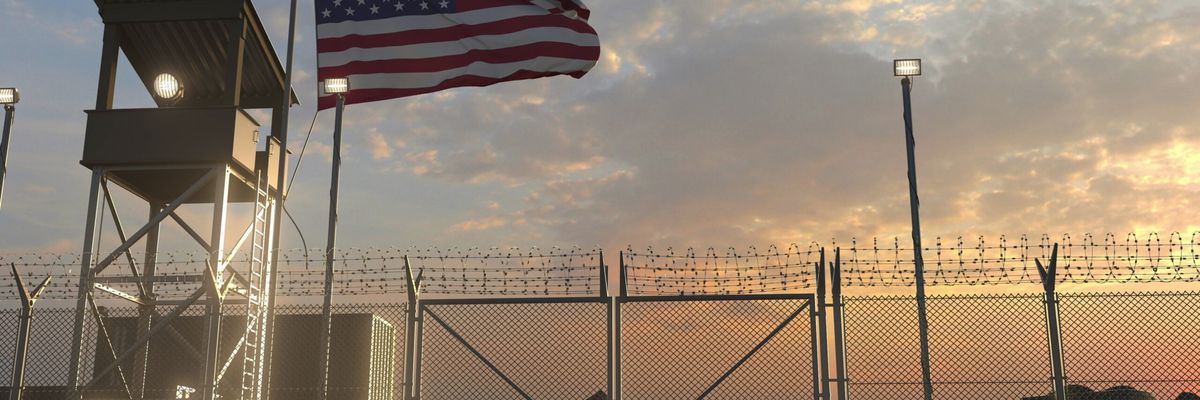Largely overlooked in last week’s announcement of the U.S.–Australia nuclear-powered submarine deal is the fact that the U.S. government plans to build new U.S. military bases Down Under. In a September 16 press conference, Australia Defence Minister Peter Dutton announced plans to establish new facilities for naval, air, and ground forces with “combined logistics, sustainment, and capability for maintenance to support our enhanced activities, including…for our submarines and surface combatants” and “rotational deployments of all types of U.S. military aircraft to Australia.”
The U.S. military already has at least seven installations in Australia. While mainstream media outlets frequently raise fears of China’s “escalating military presence in the South China Sea,” the U.S. military has hundreds of bases throughout the Asia Pacific region, surrounding China’s borders. Worldwide, despite the recent withdrawal from Afghanistan, the U.S. government still maintains approximately 750 military bases abroad in 80 foreign countries and colonies, according to a new, exhaustive list of U.S. overseas military installations that I helped compile for the Quincy Institute and World BEYOND War.
That the Biden administration intends to expand the already massive collection of bases in Australia and elsewhere in the Pacific is deeply troubling. Across the political spectrum and even within the U.S. military there is growing recognition that the country has, as retired four-star U.S. Air Force General Roger Brady put it simply, “too many daggone bases” overseas. Think tank analysts, scholars, politicians, and other observers conclude that many bases abroad should have closed decades ago and are undermining U.S. and global security. “I think we have too much infrastructure overseas,” said the highest-ranking officer in the U.S. military, Joint Chiefs of Staff Chair Mark Milley, in December 2020.
Earlier this year President Biden announced a Global Posture Review to examine and ensure the deployment of U.S. military forces around the world is “appropriately aligned with our foreign policy and national security priorities.” While the administration hasn’t announced the results of the review, a military buildup Down Under would be a dangerous step in the wrong direction when base closures, not base construction, are what’s needed.
Since World War II, the United States has maintained hundreds upon hundreds of bases in foreign lands. More than 75 years after that war’s end, there are still 119 base sites in both Germany and Japan, according to the Pentagon. Located on every continent except Antarctica, U.S. bases range in size from city-sized “Little America” installations with tens of thousands of military personnel and family members to small surveillance facilities and drone airfields.
For decades most in the United States haven’t questioned the presence of these bases. Too many have assumed that if a base exists it must have a reason to be there. Too many have assumed that more bases mean more security. Unfortunately, the opposite has often been the case: more bases abroad has meant less security for the United States and the world.
Maintaining unnecessary foreign military infrastructure wastes tens of billions of tax dollars annually at a time when domestic infrastructure is crumbling, and trillions are urgently needed to respond to pandemics, global warming, and other pressing health, education, housing, and environmental needs. I conservatively estimate the annual cost of building, operating, and maintaining bases abroad at $55 billion — larger than the State Department’s entire budget.
Bases are the face of the United States globally far more than diplomats, reflecting the dangerous, longstanding militarization of foreign policy: the 750 bases abroad are nearly three times the number (276) of U.S. embassies, consulates, and missions worldwide. While a few other countries maintain foreign bases on other nations’ lands, the United States controls the vast majority. The United Kingdom, France, Russia, Turkey, and a few other countries likely have around 200 foreign bases combined. China has five foreign installations (plus bases in Tibet).
Bases abroad also raise geopolitical and military tensions, encouraging countries like China, Russia, Iran, and North Korea to boost their own military spending (and foreign base construction) when encircled by U.S. bases. How would U.S. leaders respond if China or Russia were to build a single base near a U.S. border?
As our new QI report and bases list show, U.S. installations are blocking the spread of democracy in at least 38 non-democratic countries and colonies. Bases in the U.S. colonies (“territories”) of Puerto Rico, Guam, the Northern Mariana Islands, American Samoa, and the U.S. Virgin Islands have helped perpetuate their colonial relationship with the rest of the United States.
Bases abroad frequently cause significant environmental damage, harming and angering locals. Deadly accidents and crimes by U.S. military personnel, including rapes and murders, coupled with occupying other people’s lands also contribute to generating understandable protest and damaging the reputation of the United States. While the vast majority of protest is nonviolent, one of Osama bin Laden’s justifications for al Qaeda’s 9/11 attacks was the U.S. military presence in the Muslim holy land of Saudi Arabia.
Some will say the United States must maintain hundreds of bases overseas to keep the peace and make the United States and the world safer by deterring enemies. To that I say: Prove it. They can’t. There is no conclusive evidence showing that U.S. bases overseas are an effective and strategically useful deterrent. Meanwhile, the last 20 years of endless war show how foreign bases have made it easier for U.S. leaders to launch and wage disastrous wars of aggression, like those in Afghanistan, Iraq, Yemen, Somalia, Libya, and 20 other countries where U.S. troops have deployed into combat.
The Biden administration can still reverse course to close bases abroad and abandon plans to build new ones in places like Australia. Presidents George H.W. Bush, Bill Clinton, and George W. Bush closed hundreds of unnecessary bases in Europe and Asia in the 1990s and 2000s. Congress doesn’t need to be involved in overseas closures given the absence of a Base Realignment and Closure (BRAC) process abroad; however, members should support closing installations overseas to return thousands of military personnel and family members — and their paychecks — to their districts and states. There is considerable excess capacity for returning troops and families at domestic bases.
In contrast to former President Donald Trump’s hasty withdrawal of bases and troops from Syria, Biden can close bases carefully and responsibly, assuring allies, saving money, and building back the U.S. diplomatic presence worldwide. “Draw Down/Build Up” should be the mantra: Draw down the base posture abroad, bring troops and their families home, and build up the country’s diplomatic posture and alliances. Continuing to maintain 750 bases overseas and building new ones in Australia is a frighteningly irresponsible policy that, most frighteningly, is escalating military tensions with China, making what should be an unthinkable war with the nuclear-armed competitor more likely rather than less.
















